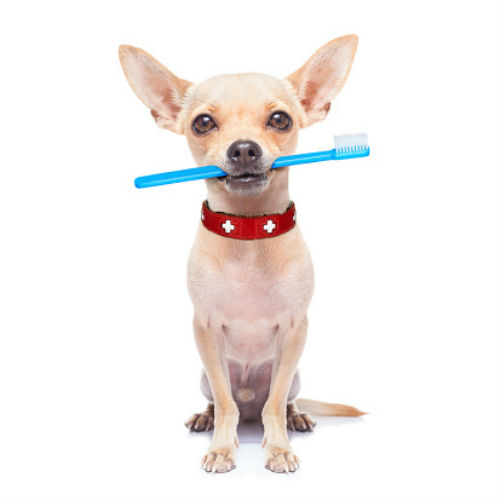One of the most commonly recognized health issues of small breeds is dental disease. Find out why this problem is so prevalent in toys and what to do about it.
My little dogs all have terrible breath. Why is this?
This sour milk odor is usually a sign of dental disease, also called periodontal disease. It usually results from bacteria associated with calculus, plaque, unhealthy gums, or decomposing food particles, and from rotting teeth or degenerative gingivitis. It gets worse over time: As the inflammation and bacteria growth continue, the socket anchoring the tooth becomes a pocket that accumulates putrefied food, bacteria, and dying tissue. All of these processes contribute to the harsh smell. But the smell is the least of the problems— periodontal disease can lead to issues in the heart, liver, and kidneys, not to mention pain and discomfort.

Why do toy dogs have such problems with dental disease?
Toy breeds have tiny mouths, but their teeth are relatively large. This combination results in very crowded conditions that lead to dental disease. The crowding creates more crevices and surfaces where tartar and plaque can accumulate, and as we all know, tartar and plaque buildup leads to periodontal disease. In addition, these small dogs don’t have a lot of bone in their jaws and between the roots of the tooth, making it possible for periodontal disease to affect the jawbones. The situation gets even worse when dogs have retained deciduous teeth (baby teeth that did not fall out), which add further to the crowding, as do abnormal roots, crowns, and jaws (overbite or underbite).
What about anesthesia-free cleaning? Isn’t that safer?
Some have proposed that anesthesia-free dental scalings are safer and less expensive methods to clean teeth. Unfortunately, although this procedure may improve the appearance of teeth due to removal of visible calculus, it does little for treating under the gums where periodontal disease exerts the most effect upon the animal’s health. Other common problems that can be discovered during cleaning include fractured teeth, areas of tooth re- sorption, and gingival enlargement, all of which require dental X-rays to fully assess the pathology and guide a treatment plan.
Although any anesthetic procedure does carry some risk, if done correctly, the risk is extremely low. Pre-anesthetic blood work, extensive monitoring (including pulse oximetry, blood pressure, EKG, and body temperature) during the procedure, and an experienced staff all contribute to anesthetic safety.
Talk to your veterinarian to establish a tailor-made dental strategy that takes into account your dog’s age and breed and your ability to carry out what is required.

What can be done about it?
Start early with your puppy, teaching him to allow you to both examine his mouth and brush his teeth. Regular brushing, combined with dental products, like chews, food, wipes, or water additives, can help preserve our dogs’ teeth. Also, prophylactic dental cleanings, done by a veterinary professional while the dog is under anesthesia, should be part of your dog’s regular care.
Originally published in AKC Family Dog


